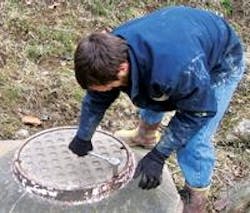Banishing Backups
The village of Waterford in southern Wisconsin is a community surrounded by several rivers. It serves 5,000 customers with average flows of 500,000 gal per day (gpd). The oldest part of the village was built in the 1900s. For years, officials have struggled to prevent recurring backups in an environmentally responsible manner. Assistant Director of Public Utilities James Bergles said he and his team spent many hours addressing these issues and resolving them. One of the problem areas was an unmonitored siphon well. Grease, oil and heavy rains negatively impacted the performance of the well. Bergles knew it was going to take a specialized product to monitor the area.
The River Street gravity siphon well is located 15 ft away from one of the rivers in town. It is near many houses, restaurants and a high school. A gravity siphon well doesn’t use power to move sewage. Instead, it relies on gravity and atmospheric pressure. The sewage travels under the river to the manhole on the opposite side of the river. Grease and oil buildup from nearby restaurants frequently inhibit the well. During heavy rain, the well also is overwhelmed with surge flows. These two factors significantly decrease the performance of the well. With no monitoring equipment in place, this presented a significant problem to the village utility.
“We haven’t had any sanitary sewer overflows, but we have experienced basement backups with a nearby resident,” Bergles said. “The homeowner is quick to call when there’s a backup in their basement.”
The remote location of the well made it difficult to provide AC power for a monitoring device. Bergles knew it was going to take a specialized product to monitor the area. He considered the Manhole Monitor, designed and manufactured by Mission Communications.
“We like that it’s plug-and-play and no external power is required,” Bergles said. “Other than the preemptive alarms, we wanted the monitoring device to blend in with the aesthetics of the natural environment. The well is actually located in the middle of a flower bed, and we were able to make the in-ground antenna blend in with it.”
The monitor sends notifications when the level in the well begins to rise. This gives utility workers a chance to tend to the well and clean it before a backup occurs. The monitoring device has helped the village utility prevent any basement backups. Workers had to raise the floats about 2 in. because heavy rain events would trigger an early alarm.
“Most of the time, the level drops back down because it’s still flowing,” Bergles said. “When the float is triggered and we receive an alarm, we know there is a problem.
“The Manhole Monitor is great,” Bergles added. “We are definitely planning on placing them in more wells and manholes.”
Bergles can obtain reports on the Mission Web portal. When the utility installs additional monitors, personnel will be able to compare historical data. Reports show high level and surcharge events in comparison to the rainfall documented by the local National Oceanic and Atmospheric Administration station.
The village continues to update its equipment and its infrastructure.
City of Clarksburg, W.Va.
The city of Clarksburg, W.Va., manages a combined sewer system that originally was built in the early 1950s. Treatment plant capacity currently is 8 mgd. With heavy rain events, the sewer system takes in up to 12 million gal. Wastewater Treatment Plant Superintendent Paul Lehosit and his team have spearheaded a long-term control plan to improve the entire collection system. Lehosit has worked closely with the West Virginia Department of Environmental Protection (DEP) to accomplish this task. DEP approved a $12-million upgrade, which includes monitoring equipment on each of the city’s 56 combined sewer overflow (CSO) manholes. The city currently has Manhole Monitors on four of its most active CSO manhole sites. Lehosit plans on installing the monitors at additional CSO manhole locations.
“We’ve been using the Mission system for nearly three years. The data and charts that we get from the Web portal are so helpful when it comes to preparing the reports that we submit to the DEP,” Lehosit said.
Before using Mission for its CSO monitoring, the city of Clarksburg used a different device that required daily site visits by CSO inspector Jody Ash to download data. He said the new system is an improvement. “The data from the Mission system comes straight to our website,” Ash said. “We don’t have to go out of our way to get it. Ultimately, this gives us more time to focus on other tasks.”
Ash uses the monitor to track the duration of overflows. He monitors when an overflow starts and stops during a heavy rainfall. The monitor sends early notifications when the float is tipped, but Ash said that because it is a combined system, there is nothing the city can do to stop the CSO manholes from overflowing. “The rain is our biggest enemy. We are confident that this new upgrade, along with the monitors will completely eliminate the overflows,” Ash said.
According to Ash, the monitors are very easy to install inside the manholes. “It has cut installation time in half,” he said. “There is no wiring. You just plug it in and it’s good to go.”
Online data access and reliability of alarms have given staff more time to spend on other projects. The utility has achieved a significant savings in operations and maintenance schedules with a 50% reduction in site visits. Ash still makes daily visits to the most active CSO manholes to double check their status. Lehosit said he hopes the monitors will help detect non-rainfall-related problems in the city of Clarksburg once the upgrade is complete.
